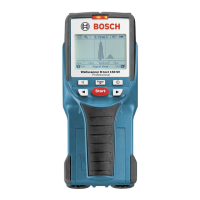20 | English
1 619 929 J48 | (1.7.11) Bosch Power Tools
Device Information
In the “Device Info” menu, information on the measuring tool
is provided, e.g., about the “Operation Time”.
In the “Restore Settings” menu, you can restore the factory
settings.
Examples for Measuring Results
Note: In the following examples, the audio signal on the meas-
uring tool is switched on.
Depending on the size and depth of the object under the sen-
sor range, it is not always possible to positively determine
whether this object is “live” or voltage-free. In this case, the
symbol will appear in indicator n.
“Live” Wire (see figure C)
A “live”, metal object (e. g. a power cable) is within the sensor
range. The object depth is 1.5 cm. The measuring tool emits
the warning signal for “live” conductors as soon as the power
cable is detected by the sensor.
Steel Bar (see figure D)
A magnetic object (e.g. a steel bar) is within the sensor range.
Further objects are also located to the left and right, outside
of the sensor range. The object depth is 5.5 cm. The measur-
ing tool emits an audio signal.
Copper Pipe (see figure E)
A metal object (e. g. a copper pipe) is within the sensor range.
The object depth is 4 cm. The measuring tool emits an audio
signal.
Plastic or Wooden Object (see figure F)
A non-metal object is within the sensor range. The object is
plastic or wooden, and close to the surface. The measuring
tool emits an audio signal.
Large Surface (see figure G)
A metal, large surface (e. g. a metal plate) is within the sensor
range. The object depth is 2 cm. The measuring tool emits an
audio signal.
Many Unclear Signals (see figures H–I)
When many objects are shown in the standard start display,
the wall probably consists of many hollow spaces. To broadly
block out the hollow spaces, switch to the “Metal ”operating
mode. When there are still too many objects being shown,
carry out several height-offset measurements and mark the
detected objects on the wall. Offset marks are an indication
for hollow spaces, whereas marks on a line indicate an object.
Troubleshooting – Causes and Corrective Measures
?
Error Cause Corrective Measure
Measuring tool cannot be switched on
Batteries empty Replace batteries
Batteries incorrectly in-
serted (wrong polarity)
Check if the batteries are inserted correctly
Measuring tool switched on but does not
react
Take out batteries and reinsert again
Measuring tool too warm or
too cold
Wait until operating temperature range is reached
Display indication: “Slipping Wheel”
Wheel losing contact with
the surface
Press the start button 11 and take care that the
two bottom wheels have contact with the wall
while moving the measuring tool; in case of uneven
walls, position a thin piece of cardboard between
the wheels and the wall
Display indication: “Speeding” Measuring tool has been
moved to quickly
Press the start button 11 and move measuring tool
slowly over the wall
“Temperature over range” Wait until operating temperature range is reached
“Temperature under
range”
Wait until operating temperature range is reached
“Strong radio signal
detected”
Measuring tool switches off automatically. If possi-
ble, eliminate the interfering radio waves, e.g.
WLAN, UMTS, radar, transmitter masts or micro-
waves, then switch the measuring tool on again.
OBJ_BUCH-1478-001.book Page 20 Friday, July 1, 2011 8:48 AM

